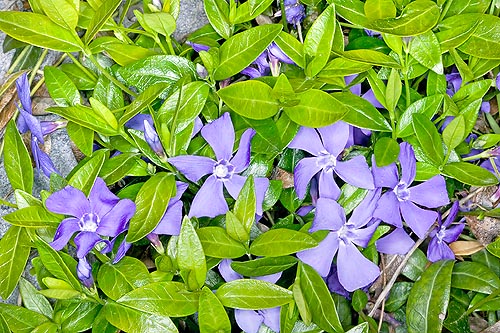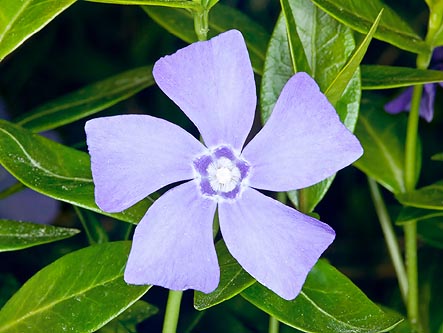Family : Apocynaceae

Text © Pietro Puccio

English translation by Mario Beltramini

The Vinca minor is known, since ages, for its medicinal virtues © Giuseppe Mazza
The Vinca minor L. (1753) is native to hedges and shady woods of southern Europe and of the central one up to the Caucasus, both in the plains and in the hills ; in Italy, it is native all over its territory, Sicily included, but Sardinia.
The name of the genus, after some, comes from the Latin “vincire” = to tie up, with reference to the thin and strong stems utilized for making wreaths, after others, from “vincere” = to prevail, as it is evergreen and, therefore, able to “prevail” over the winter.
The Latin name of the species “minor” = minor, has been given in order to distinguish it from the similar plant Vinca major.
Common names: “pervinca” (Italian); “common periwinkle”, “lesser periwinkle”, “running-myrtle”, “creeping myrtle”, “flower-of-death” (English); “petite pervenche”, “violette des sorcières”, “violette des morts”, “violette des serpents”, “herbe de fidélité” (French); “Kleines Immergrün” (German); “pervinca”, “vincapervinca”, “hierba doncella”, “violeta de asno”, “dominicana”, “dominica” (Spanish); “vinca”, “pervinca”, “violeta-das-feiticeiras”, “erva-da-inveja”; “congorsa”, “congossa”, “chachaméu”, “boas-noites” (Portuguese).
Perennial herb with thin training stems, long up to about 1 metre, and rooting at nodes with opposite leaves, lanceolate, of glossy dark green colour, long up to 3-4 cm. From the trailing stems, in spring, come out the floriferous branches, initially upright, tall up to about 30 cm, with solitary flowers of 3-5 cm of diameter, which appear at the axil of the leaves on a long peduncle.

Flower of Vinca minor © Giuseppe Mazza
The petals, somewhat irregular, are spatulate, with a generally violet-blue colour, more occasionally, white or pink. The fruits are spindle-shaped follicles containing thin seeds, long 7-8 mm. It easily reproduces by division of the stolons.
Plant known since remote ages in the popular medicine, it contains, as a matter of fact, several alkaloids, potentially toxic if ingested, the most important being the vincamine, utilized also in current medicine, in appropriate dosage, as periphery and coronary vasodilator. As ornamental plant, it is usually employed as groundcover in shady locations and in wet and rich of humus soils.
Synonyms: Pervinca minor (L.) Garsault (1764); Pervinca procumbens Gilib. (1792); Vinca humilis Salisb. (1796); Vinca ellipticifolia Stokes (1812); Vinca intermedia Tausch (1836); Pervinca heterophyla Raf. (1840); Pervinca repens Raf. (1840); Vinca acutiflora Bertol. ex W.D.J.Koch (1844); Vinca minor var. intermedia (Tausch) Nyman (1881); Vinca minor var. sabinka H.Scholz, (1982).
→ To appreciate the biodiversity within the APOCYNACEAE family please click here.
